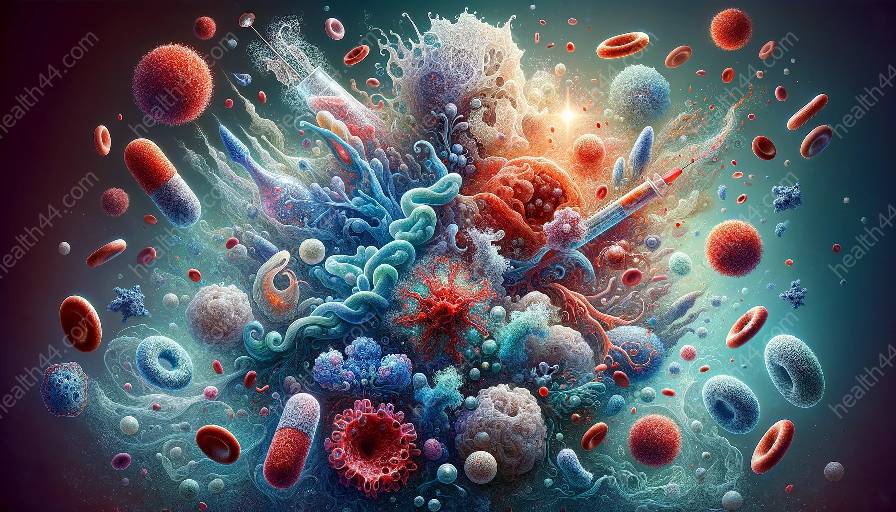Antigen recognition and processing play a pivotal role in the body's immune response, impacting both immunopathology and immunology. This cluster will delve into the intricacies of how the immune system identifies and processes antigens, and the subsequent implications for health and disease.
Understanding the Basics of Antigen Recognition and Processing
Antigen recognition is the process by which the immune system identifies and binds to antigens, which are substances that can induce an immune response. Antigens can be proteins, carbohydrates, lipids, or nucleic acids, and they are often derived from pathogens, such as bacteria, viruses, or parasites, or from non-pathogenic sources, such as allergens.
Once an antigen is recognized, it undergoes processing, which involves breaking it down into smaller fragments called peptides. This process occurs within antigen-presenting cells (APCs), such as dendritic cells, macrophages, and B cells. The peptides generated during antigen processing are then presented on the surface of the APCs in complex with major histocompatibility complex (MHC) molecules.
Antigen Presentation and Immune Recognition
After processing, the antigen-derived peptides presented on MHC molecules are recognized by T cells through their T cell receptors (TCRs). The interaction between the peptide-MHC complex and the TCR triggers a cascade of signaling events, leading to the activation of T cells.
There are two main classes of MHC molecules: class I and class II. Class I MHC molecules present peptides derived from intracellular pathogens, such as viruses, to CD8+ cytotoxic T cells. In contrast, class II MHC molecules present peptides derived from extracellular pathogens to CD4+ helper T cells.
Furthermore, B cells can also present antigens to T cells by capturing and processing antigens through their B cell receptors. Upon recognizing antigens, B cells can differentiate into plasma cells and produce antibodies specific to the antigens, thus marking them for destruction.
Role in Immunopathology
The process of antigen recognition and processing is closely intertwined with immunopathology—the study of disease states associated with dysfunction of the immune system. Dysregulation of antigen recognition and processing can lead to a range of immunopathological conditions, including autoimmune diseases, hypersensitivity reactions, and immunodeficiency disorders.
Autoimmune diseases occur when the immune system mistakenly recognizes self-antigens as foreign and mounts an immune response against healthy tissues. This breakdown in tolerance can result from defects in central or peripheral tolerance mechanisms, leading to the development of conditions such as rheumatoid arthritis, systemic lupus erythematosus, and type 1 diabetes.
Hypersensitivity reactions, on the other hand, occur when the immune system overreacts to harmless antigens, leading to inflammatory responses that cause tissue damage. The classification of hypersensitivity reactions into four types—type I, type II, type III, and type IV—illustrates various mechanisms by which antigen recognition and processing can lead to immunopathology.
In contrast, immunodeficiency disorders arise from defects in antigen recognition and processing that compromise the immune system's ability to defend against pathogens. Primary immunodeficiencies, such as severe combined immunodeficiency (SCID) and common variable immunodeficiency (CVID), are often characterized by impaired T cell, B cell, or phagocyte function, resulting in recurrent infections and an increased susceptibility to opportunistic pathogens.
Implications for Immunology
Studying antigen recognition and processing has broad implications for the field of immunology, contributing to the understanding of immune responses and the development of immunotherapies and vaccines. By unraveling the complex mechanisms involved in antigen recognition, researchers can design novel strategies to modulate immune responses for therapeutic purposes.
Additionally, advances in antigen recognition and processing have led to significant progress in cancer immunotherapy, where the immune system is manipulated to recognize and eliminate cancer cells. Therapies like checkpoint inhibitors and chimeric antigen receptor (CAR) T cells utilize the principles of antigen recognition to enhance anti-tumor immune responses, ultimately improving patient outcomes.
Conclusion
The intricate process of antigen recognition and processing forms the cornerstone of both immunopathology and immunology. Understanding how the immune system identifies, processes, and presents antigens provides valuable insights into the mechanisms underlying health and disease. From autoimmune diseases to immunodeficiency disorders, the impact of antigen recognition and processing is far-reaching, shaping our understanding of immunological processes and paving the way for innovative therapeutic interventions.


